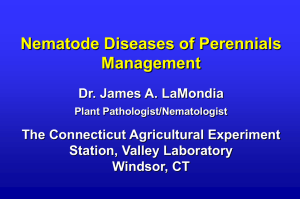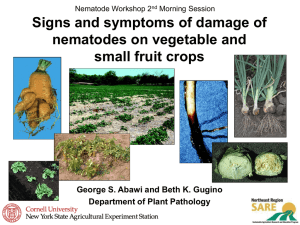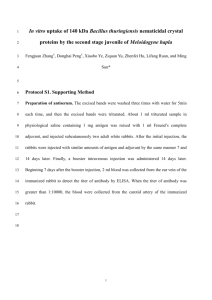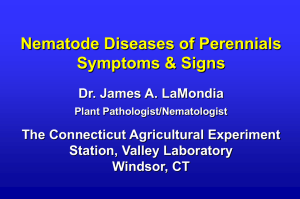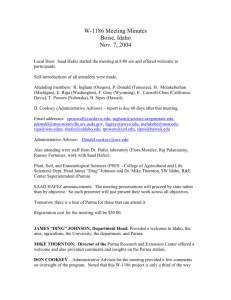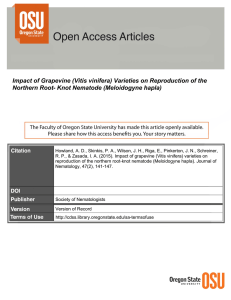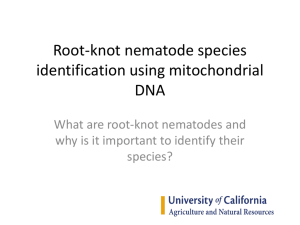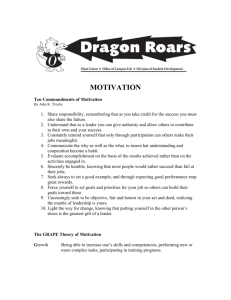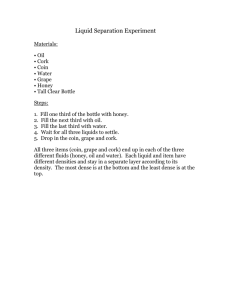here - Zasada Lab
advertisement
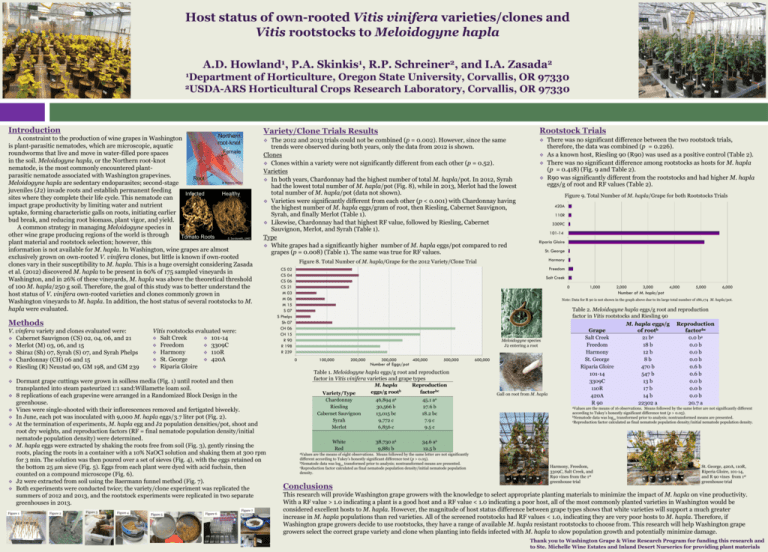
Host status of own-rooted Vitis vinifera varieties/clones and Vitis rootstocks to Meloidogyne hapla A.D. Howland1, P.A. Skinkis1, R.P. Schreiner2, and I.A. Zasada2 1Department of Horticulture, Oregon State University, Corvallis, OR 97330 2USDA-ARS Horticultural Crops Research Laboratory, Corvallis, OR 97330 Introduction Northern A constraint to the production of wine grapes in Washington root-knot is plant-parasitic nematodes, which are microscopic, aquatic Female roundworms that live and move in water-filled pore spaces in the soil. Meloidogyne hapla, or the Northern root-knot nematode, is the most commonly encountered plantparasitic nematode associated with Washington grapevines. Root JB Ristaino, NCSU Meloidogyne hapla are sedentary endoparasites; second-stage juveniles (J2) invade roots and establish permanent feeding Infected Healthy sites where they complete their life cycle. This nematode can impact grape productivity by limiting water and nutrient uptake, forming characteristic galls on roots, initiating earlier bud break, and reducing root biomass, plant vigor, and yield. A common strategy in managing Meloidogyne species in other wine grape producing regions of the world is through Tomato Roots S. Sardanelli, UMD plant material and rootstock selection; however, this information is not available for M. hapla. In Washington, wine grapes are almost exclusively grown on own-rooted V. vinifera clones, but little is known if own-rooted clones vary in their susceptibility to M. hapla. This is a huge oversight considering Zasada et al. (2012) discovered M. hapla to be present in 60% of 175 sampled vineyards in Washington, and in 26% of these vineyards, M. hapla was above the theoretical threshold of 100 M. hapla/250 g soil. Therefore, the goal of this study was to better understand the host status of V. vinifera own-rooted varieties and clones commonly grown in Washington vineyards to M. hapla. In addition, the host status of several rootstocks to M. hapla were evaluated. Variety/Clone Trials Results Rootstock Trials The 2012 and 2013 trials could not be combined (p = 0.002). However, since the same trends were observed during both years, only the data from 2012 is shown. Clones Clones within a variety were not significantly different from each other (p = 0.52). Varieties In both years, Chardonnay had the highest number of total M. hapla/pot. In 2012, Syrah had the lowest total number of M. hapla/pot (Fig. 8), while in 2013, Merlot had the lowest total number of M. hapla/pot (data not shown). Varieties were significantly different from each other (p < 0.001) with Chardonnay having the highest number of M. hapla eggs/gram of root, then Riesling, Cabernet Sauvignon, Syrah, and finally Merlot (Table 1). Likewise, Chardonnay had that highest RF value, followed by Riesling, Cabernet Sauvignon, Merlot, and Syrah (Table 1). Type White grapes had a significantly higher number of M. hapla eggs/pot compared to red grapes (p = 0.008) (Table 1). The same was true for RF values. Methods V. vinfera variety and clones evaluated were: Cabernet Sauvignon (CS) 02, 04, 06, and 21 Merlot (M) 03, 06, and 15 Shiraz (Sh) 07, Syrah (S) 07, and Syrah Phelps Chardonnay (CH) 06 and 15 Riesling (R) Neustad 90, GM 198, and GM 239 Vitis rootstocks evaluated were: Salt Creek 101-14 Freedom 3309C Harmony 110R St. George 420A Riparia Gloire Figure 1 Figure 2 Figure 3 Figure 4 Figure 5 Figure 6 Figure 7 Figure 9. Total Number of M. hapla/Grape for both Rootstocks Trials 420A 110R 3309C 101-14 Riparia Gloire St. George Harmony Figure 8. Total Number of M. hapla/Grape for the 2012 Variety/Clone Trial Freedom CS 02 CS 04 CS 06 CS 21 M 03 M 06 M 15 S 07 S Phelps Sh 07 CH 06 CH 15 R 90 R 198 R 239 Salt Creek 0 1,000 2,000 3,000 4,000 5,000 6,000 Number of M. hapla/pot Note: Data for R 90 is not shown in the graph above due to its large total number of 186,174 M. hapla/pot. Table 2. Meloidogyne hapla eggs/g root and reproduction factor in Vitis rootstocks and Riesling 90 W. Wergin and R. Sayre, USDA Meloidogyne species J2 entering a root 0 Dormant grape cuttings were grown in soilless media (Fig. 1) until rooted and then transplanted into steam pasteurized 1:1 sand:Willamette loam soil. 8 replications of each grapevine were arranged in a Randomized Block Design in the greenhouse. Vines were single-shooted with their inflorescences removed and fertigated biweekly. In June, each pot was inoculated with 9,000 M. hapla eggs/3.7 liter pot (Fig. 2). At the termination of experiments, M. hapla egg and J2 population densities/pot, shoot and root dry weights, and reproduction factors (RF = final nematode population density/initial nematode population density) were determined. M. hapla eggs were extracted by shaking the roots free from soil (Fig. 3), gently rinsing the roots, placing the roots in a container with a 10% NaOCl solution and shaking them at 300 rpm for 3 min. The solution was then poured over a set of sieves (Fig. 4), with the eggs retained on the bottom 25 µm sieve (Fig. 5). Eggs from each plant were dyed with acid fuchsin, then counted on a compound microscope (Fig. 6). J2 were extracted from soil using the Baermann funnel method (Fig. 7). Both experiments were conducted twice; the variety/clone experiment was replicated the summers of 2012 and 2013, and the rootstock experiments were replicated in two separate greenhouses in 2013. There was no significant difference between the two rootstock trials, therefore, the data was combined (p = 0.226). As a known host, Riesling 90 (R90) was used as a positive control (Table 2). There was no significant difference among rootstocks as hosts for M. hapla (p = 0.418) (Fig. 9 and Table 2). R90 was significantly different from the rootstocks and had higher M. hapla eggs/g of root and RF values (Table 2). 100,000 200,000 300,000 Number of Eggs/pot 400,000 500,000 600,000 Table 1. Meloidogyne hapla eggs/g root and reproduction factor in Vitis vinifera varieties and grape types Variety/Type Chardonnay Riesling Cabernet Sauvignon Syrah Merlot White Red M. hapla eggs/g rootb Reproduction factorbc 46,894 aa 30,566 b 13,015 bc 9,772 c 6,856 c 45.1 aa 27.6 b 18.2 bc 7.9 c 9.5 c 38,730 aa 9,881 b 34.6 aa 12.5 b are the means of eight observations. Means followed by the same letter are not significantly different according to Tukey’s honestly significant difference test (p > 0.05). bNematode data was log transformed prior to analysis; nontransformed means are presented. 10 cReproduction factor calculated as final nematode population density/initial nematode population density. Gall on root from M. hapla Grape Salt Creek Freedom Harmony St. George Riparia Gloire 101-14 3309C 110R 420A R 90 M. hapla eggs/g of rootb 21 ba 18 b 12 b 8b 470 b 547 b 13 b 17 b 14 b 22302 a Reproduction factorbc 0.0 ba 0.0 b 0.0 b 0.0 b 0.6 b 0.6 b 0.0 b 0.0 b 0.0 b 20.7 a aValues are the means of 16 observations. Means followed by the same letter are not significantly different according to Tukey’s honestly significant difference test (p > 0.05). bNematode data was log transformed prior to analysis; nontransformed means are presented. 10 cReproduction factor calculated as final nematode population density/initial nematode population density. aValues Conclusions Harmony, Freedom, 3309C, Salt Creek, and R90 vines from the 1st greenhouse trial St. George, 420A, 110R, Riperia Gloire, 101-14, and R 90 vines from 1st greenhouse trial This research will provide Washington grape growers with the knowledge to select appropriate planting materials to minimize the impact of M. hapla on vine productivity. With a RF value > 1.0 indicating a plant is a good host and a RF value < 1.0 indicating a poor host, all of the most commonly planted varieties in Washington would be considered excellent hosts to M. hapla. However, the magnitude of host status difference between grape types shows that white varieties will support a much greater increase in M. hapla populations than red varieties. All of the screened rootstocks had RF values < 1.0, indicating they are very poor hosts to M. hapla. Therefore, if Washington grape growers decide to use rootstocks, they have a range of available M. hapla resistant rootstocks to choose from. This research will help Washington grape growers select the correct grape variety and clone when planting into fields infected with M. hapla to slow population growth and potentially minimize damage. Thank you to Washington Grape & Wine Research Program for funding this research and to Ste. Michelle Wine Estates and Inland Desert Nurseries for providing plant materials
